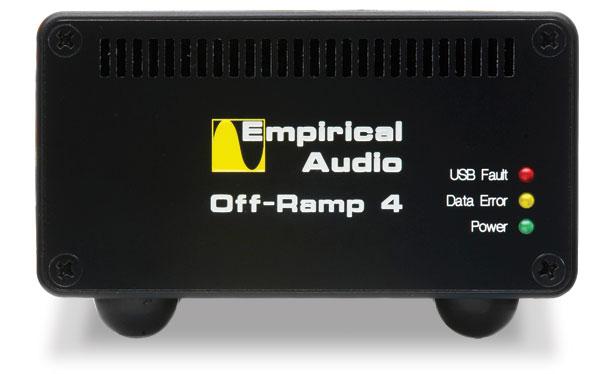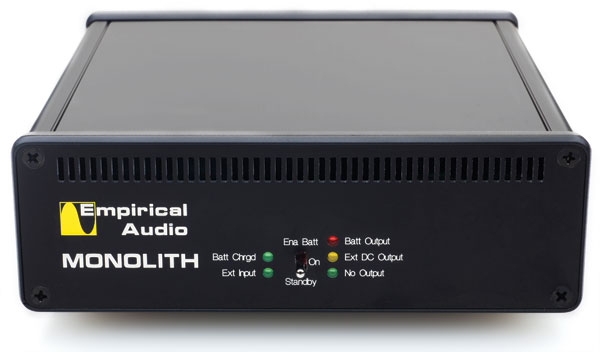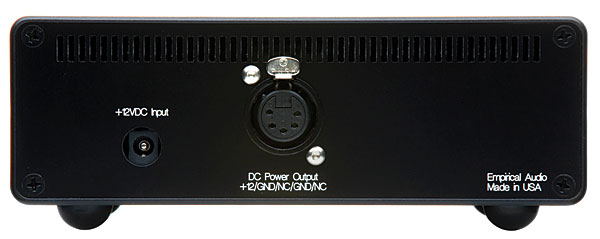| Columns Retired Columns & Blogs |
Very interesting review. I look forward to seeing a comparison to the Alpha USB. I thought it was too expensive for a USB converter ($1600), but it looks like a potential bargin compared to the Offramp 4.

Fact is, the predominant digital source at audio shows is now a computer, and Stereophile has been covering the components required to extract audio data from computers for some time now (footnote 1). My beat has been to review products intended to transform a USB feed into the AES/EBU or S/PDIF serial datastream needed to drive a traditional outboard D/A converter. The subject of this review, Empirical Audio's Off-Ramp 4, does the same thing, but at prices that range from $799 for the basic model to $3068 for a fully tricked-out version with outboard battery supply, it's significantly more expensive than the similar products I've reviewed in the past. My review sample included the Dual Turboclock ($700) option, to which I added the Monolith lithium-ion battery supply ($1199), for a total price of $2698.
This review was long in gestation because the Off-Ramp 4 proved somewhat of a moving target. I returned the sample three times to Empirical for upgrading before I could crystallize my findings, and as I finished up the review, I found out that an upgrade of the voltage regulators, a $300 option, had just been introduced. Empirical's Steve Nugent explained in an e-mail that, "As in most of my products, there are modules that I upgrade over time. My products are not just as-is. They are moving targets, getting constant improvement which can make them a bit difficult to review at times. The customers however love this because they are not buying into obsolescence. Especially important for Computer Audio, which is constantly evolving. They know that down the road when new technologies and improvements come along, they can upgrade and don't have to sell their older gear and shop for something new."
Technology
The Off-Ramp 4 is a small box: a rectangular-section, black-anodized aluminum extrusion with black endcaps. The front has three status LEDs; the rear has a USB port, an XLR jack for the AES/EBU output, an RCA jack for the S/PDIF output, an RJ-45 jack for the I2S output (footnote 2) and a DC input jack. Unlike other USB converters, which are USB 1.1–compliant and are thus limited to 24-bit/96kHz audio data, the Off-Ramp 4 conforms to the faster USB 2.0 specification and can handle 24/192 datastreams. However, a driver program is required for each operating system used by the host computer, which Empirical supplies on a CD-R. (These can also be downloaded from Empirical's website.)

Inside the Off-Ramp 4, a motherboard runs the full width and depth of the enclosure. The USB port is connected to a daughterboard populated with surface-mount components on its upper and lower sides. The USB receiver on this board uses, under license, programmed parts from Italian company M2Tech that, Steve Nugent says, are similar to those used in the M2Tech hi-Face USB bridge. These are a programmable USB interface chip from Cypress Semiconductor (a CY7C68013A, which includes an onboard microcontroller), and a programmed flash memory and programmed Xilinx FPGA for the clock division and buffering. An AKM AK4114 chip checks the signal integrity and lights the amber data-error LED if non-PCM data are detected. A red LED lights if no USB data are present. A green LED indicates that valid PCM data are present at the USB input.

As can be seen in the photo of the Off-Ramp's innards, two shielded clock links are taken to this board from the master clock circuit, which resides on another daughterboard. The review sample's Dual Turboclock option uses a high-precision crystal oscillator for each of the two sample-rate families: 44.1, 88.2, and 176.4kHz; and 48, 96, and 192kHz. All sample rates are generated by dividing the frequency of these two clocks, and each oscillator circuit is powered from its own discrete voltage regulator with heatsink..
The output of the USB receiver board appears to be taken to a second AK4114 chip, which provides the S/PDIF, AES/EBU, and I2S outputs. Steve Nugent ranks the sound quality potential of the data outputs as I2S, then S/PDIF, then AES/EBU. The overall parts and construction qualities are high; I spotted at least one premium Black Gate electrolytic capacitor.
Power is taken from a DC jack on the rear panel with a positive-center 2.5mm pin. The circuits are protected from reverse voltage. A 12VDC wall-wart power supply is provided, but a sophisticated outboard battery supply, the Monolith, is also available. The Monolith can be used with Empirical Audio's Pace-Car and Overdrive DAC products as well as the Off-Ramp, and has three pairs of lithium-ion cells and the necessary charging and management circuitry. A Neutrik five-pin high-current connector on the Monolith's rear panel supplies 12V and a ground return. The Monolith is powered from the same wall wart supplied with the Off-Ramp; a toggle switch on the Monolith's front panel selects off/charge or AC power on, with a momentary position selecting battery operation.

The Monolith will not operate without a source of power, but when the batteries are fully charged, the AC adapter is disconnected from the output. When the batteries are discharged to the point where they might start to affect the sound quality, the Monolith automatically and transparently switches the AC adapter back to the output, disconnects the LI batteries, and begins charging them.

Sound Quality
Setup was as easy as installing the correct driver for my operating system—my 2006 G4 Mac mini runs OS X 10.5 (Leopard), the final version compatible with its obsolete G4 processor—connecting the Off-Ramp 4 to one of the computer's USB ports, and connecting its AES/EBU output to a D/A processor. (I don't like RCA-connected S/PDIF outputs and the review sample didn't have the optional 75 ohm BNC connector.)
Prior to auditioning the Off-Ramp 4, I'd been using the BNC version of the Halide Bridge USB-S/PDIF converter ($450, reviewed in December 2010), with the Logitech Transporter used as a D/A converter. With music served from my Mac mini running Pure Music, I felt I had reached a plateau in the quality of my system's source: an easy sound that wasn't too laid-back, with a wide, deep soundstage, and a full presentation of recorded detail that wasn't thrust in my face. Then, in place of the Halide, I hooked up the Empirical Audio Off-Ramp 4, powered from its wall-wart supply.
Now that was interesting. The soundstage got a little wider and deeper without becoming unstable. Individual objects within that soundstage, such as the treble recorder, oboe, trumpet, and violin in J.S. Bach's Brandenburg Concerto 2, with Richard Egarr directing the Academy of Ancient Music (24/88.2 download, Harmonia Mundi HMU 807461.62), got a little smaller but were actually slightly better focused.
I went back to the Halide, and the stage both shrank a little and lost a very slight degree of image focus. I returned to the Off-Ramp 4 and heard the same improvement I had before. I then powered the Off-Ramp 4 from the Monolith battery supply: the differences I'd heard between the Halide and Off-Ramp became more intense. Despite the complex interplay between the voices at the start of the Dunedin Consort's performance of Bach's St. Matthew Passion (24/88.2 Studio Master download, Linn CKD 313P), each voice retained its own space within the soundstage.
Footnote 2: The I2S bus is a proprietary digital-audio-data interconnection standard intended by its progenitor, Philips, to be used inside a CD player or digital control center. As it runs a separate connection for the data clock signal, it is less prone to introducing jitter into the recovered clock than the S/PDIF and AES/EBU data protocols, in which the clock is embedded in and needs to be extracted from the data.

Very interesting review. I look forward to seeing a comparison to the Alpha USB. I thought it was too expensive for a USB converter ($1600), but it looks like a potential bargin compared to the Offramp 4.

Did I miss something in your article ?
"Up to this point I'd been using a generic USB cable with the Off-Ramp. I now substituted the expensive AudioQuest Coffee cable ($295/1.5m). If I heard a difference, it was very small, but if I had to swear on J. Gordon Holt's unwritten autobiography, I'd say that the AQ continued in the same direction the improvement I'd heard with the battery supply."
"I spent the rest of that day trying to measure the differences between these two USB cables. It proved as frustrating as a snipe hunt, though I did find a very slight difference in jitter between the AudioQuest and generic cables with the Transporter: The generic USB cable was better."
The Transporter does not have a USB input.

The comparisons were between the premium and generic USB cables feeding the Off-Ramp 4, which in turn fed the Transporter via AES/EBU.
John Atkinson
Editor, Stereophile

RE: " ... my 2006 G4 Mac mini runs OS X 10.5 (Leopard), the final version compatible with its obsolete G4 processor— ..."
Unlike the majority of current day Mac users, I am one of those people who bought a 68000 Mac running System 6.0.8 and have used Macs daily since that day in 1990. This means three incompatible CPU families (24 and 32-bit Motorola 680x0 series; 32 and 64-bit Motorola and IBM PowerPC series, and 64-bit Intel x86 series).
During that time I also worked extensively with WindowsOS and Linux / UNIX systems, including authoring documentation for a prominent Linux distro ( note that the typical Linux contributor would rather eat glass than write documentation).
Furthermore, I've been using the audio authoring and playback performance capabilities of these machines to the fullest as the current technologies allowed, and using the computer as a primary audio playback device in a High Fidelity Audio System for the last 20 years.
I can assure you that the Motorola/IBM G4 and IBM G5 CPU's and the associated MacOS Operating System code, third party software and Apple/3rd party hardware is not only adequate for the task, it in many aspects is superior to the Intel x86 hardware that supersedes it. It is only in the last 2 or 3 years that the x86 Macs can claim to catch up in Audio processing power to what G4 Macs could do in 2001.
I never experienced dropouts, not even once, while using G4-based Macs in real-time authoring or playback of up to 8 simultaneous 24/96 channels; it was a huge shock to discover dropouts on recorded audio files, after the musicians had gone home, of course, when reviewing with my first 2 GHz dual core Intel CPU-based Mac that, on paper, "ate for breakfast" the lowly 867Mhz G4 it replaced.
Naturally that led to further investigation on my part, and I can assure you the G4's are extremely competent audio performers (and video; you can play back12 Quicktime videos simultaneously, and actively manipulate any one video ... including scrubbing ... without a dropout on a G4 ... you might be able to simultaneously play back maybe 3 videos, don't attempt scrubbing, on the Intel x86 that first replaced it. There is much that was lost when moving from a PPC's RISC architecture to the x86's CISC when it comes to real-time data handling.
Obsolescent ... maybe. Obsolete ... hardly.